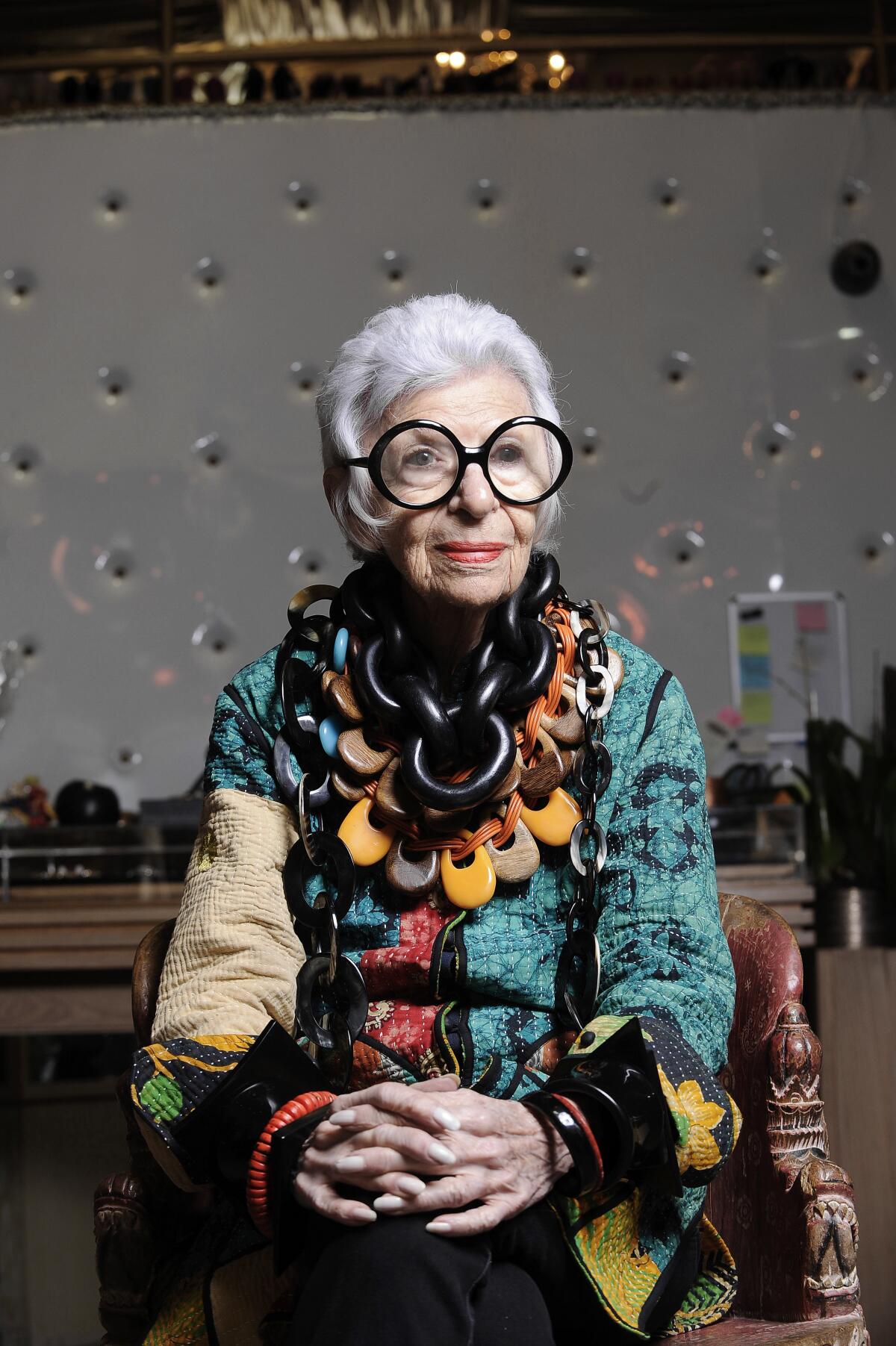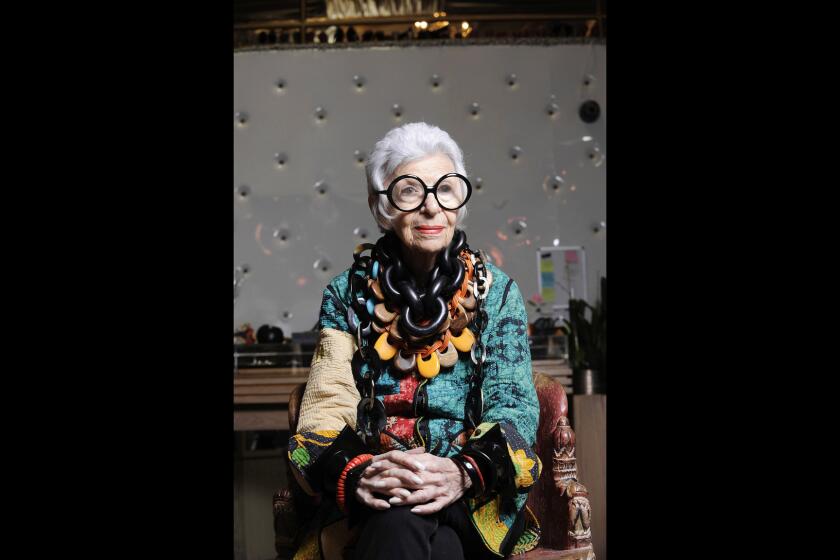Iris Apfel, beloved style icon whose fame peaked in her 90s, dies at 102

- Share via
Iris Apfel, the beloved fashion icon and interior designer whose eccentric style inspired individuality, creativity and joy, has died, according to a post on her official Instagram account. She was 102.
Known for her bold accessories, oversize round glasses and “totally mad” outfits, Apfel never let age slow her down. She was 84 when the Costume Institute of the Metropolitan Museum of Art launched an exhibition showcasing her extensive collection of garments and costume jewelry, earning her global recognition and adoration.
She was 93 when she starred in her own documentary, “Iris,” from filmmaker Albert Maysles. His portrayal of Apfel was “graced with an unforced but unmistakable charm,” wrote Times film critic Kenneth Turan in 2015.
And she was 96 when she published “Iris Apfel: Accidental Icon,” and 97 when she signed a modeling contract with global agency IMG Models, garnering the same representation as supermodels Gigi Hadid, Karlie Kloss and Kate Moss.
Long before the rise of street style blogs, Instagram and other social media, Iris Apfel was the mother of fashion individuality.
She was, in her own words, a “geriatric starlet.”
Her interior design company, Old World Weavers, was contracted with the White House and spanned nine presidencies. She also collaborated with major brands including H&M and Mattel.
But her impact extended beyond the fashion and design industries. She inspired people to embrace their individuality, to express themselves without fear of judgment and to find fun in the otherwise mundane, according to her admirers, who she said wrote her many letters.
Those who worked with and around her noticed Apfel’s undeniable spark of energy and wit. In Maysles’ film, photographer Bruce Weber, who said Apfel was one of his favorite subjects, recalled his first time meeting her.
“There were all kinds of people, all ages, all walks of life all surrounding her, she was so engaging to everybody,” he said. “I could feel the pulse of her life, of her excitement about living.”
Apfel was energized by daring fashion, and more so by the process of assembling a look, from hunting for individual pieces to mixing and matching. She was known for combining high- and low-end items and concocting dazzling ensembles that contradicted themselves in all the right ways.
“I’m just as happy to wear bangles that cost me three dollars as I am to wear valuable pieces,” she wrote in her book, “Iris Apfel: Accidental Icon.”
Her collection, which filled multiple rooms in multiple apartments, contained a waistcoat adorned with colored goose feathers and a chunky beaded necklace so large it looked like it might tip its wearer over. Apfel was an experimental trailblazer, reveling in creating looks never seen before.
“It’s not that I went out of my way to be a rebel or do things that were not socially acceptable,” she wrote, “but I learned early on that I have to be my own person to be content. ... I dress for myself.”
“I don’t go out to catch people,” the great documentarian Albert Maysles once told a class at UCLA.
Her fashion sense was joyfully eclectic and, according to former Times fashion critic Booth Moore, “a tsunami of style.”
“I like big and bold and lots of pizzazz,” Apfel said in her documentary.
Despite her cult-like following, Apfel said she never meant to become famous. She gained recognition for unapologetically being herself: “Nothing I ever did I intended to do,” she said. “It just kind of happened.”
Born Iris Barrel in the Astoria neighborhood of Queens, N.Y., in 1921, Apfel had a professional decorator for a father; her mother was a fashion boutique owner who “worshiped at the altar of the accessory.” Apfel would take the subway into Manhattan as a child and fell in love with Greenwich Village, where she began collecting an assortment of stylish pieces.
She was about 11 or 12 years old when she bought her first piece from a small shop in the basement of an old-fashioned tenement building. It was a brooch that she had fixated on and she saved 65 cents to make the purchase.
The brooch was a catalyst for her world-famous collection that eventually grew into an overflowing, international melting pot of jewelry, accessories and apparel.
Apfel studied art history at New York University and went on to attend art school at the University of Wisconsin. After graduating, she worked as a copywriter for the fashion trade journal Women’s Wear Daily.
She met her husband, Carl Apfel, on a Lake George, N.Y., vacation in 1947. They married a year later. She wore a pink lace wedding dress, she said, because she wanted a garment she could wear again that she wouldn’t have to put away in a box.
“There was something about her that just got into me,” Carl Apfel said in “Iris.” “It’s not a dull marriage, I can tell you that.”
The two were married 67 years when Carl Apfel died in 2015, three days before his 101st birthday. They had no children.
“We never wanted to,” she explained in “Iris.” “You can’t have everything. And I wanted a career and I wanted to travel.”
The Apfels co-founded their textile company, Old World Weavers, in 1950. The couple ran the business together for 42 years until they sold the company in 1992.
Old World Weavers specialized in making exact reproductions of fabrics from the 17th century onward. In the process, Apfel traveled to Turkey, Lebanon, Morocco and Europe twice a year to find textiles and weavers for their projects.
They created special fabrics for the White House across multiple administrations, including the presidencies of Truman, Kennedy and Nixon.
“Every great house in America has our stuff,” Apfel said of Old World Weavers.
Apfel was well known in the trade, but she was catapulted to fashion stardom in 2005 when the Metropolitan Museum of Art showcased her wardrobe and jewelry in a Costume Institute exhibition titled “Rara Avis: Selections From the Iris Apfel Collection.”
The exhibition, whose name translates to “rare bird,” included more than 80 styled ensembles and consisted of 300-plus accessories that Apfel had amassed over decades.
The initial idea was to showcase her costume jewelry alone, but the museum later asked Apfel to dip into her own wardrobe to style the mannequins that the jewelry would adorn. The result was a small army of Apfel’s creations: colorful, big and entirely unique.
The show “had people chattering with a heat and enthusiasm rare in the fashion world,” the New York Times reported in 2005.
Apfel’s style required both an educated visual sense and a great deal of courage, said Harold Koda, the curator in charge of the Costume Institute at the time of the exhibition. Her showcase was the first time the museum held an exhibit about clothing that was centered around a living person who wasn’t a designer.
The ensembles traveled to the Norton Museum of Art in Palm Beach, Fla.; the Nassau County Museum of Art in New York; and the Peabody Essex Museum in Salem, Mass.
After the exhibition, Apfel’s life became a whirlwind of photo shoots, media appearances and high-profile collaborations. In 2011, she was appointed visiting professor at the University of Texas at Austin in the division of textiles and apparel.
Soaring into her 90s, Apfel starred in Maysles’ documentary, published her book and signed a modeling contract. In 2018, El Segundo-based toy company Mattel released a Barbie doll in Apfel’s image, making her the oldest person ever to have a Barbie based on them.
Apfel, whose looks transcended time and trends, knew no limits when it came to accessorizing and decorating: “If you hang around long enough, everything comes back,” she said at 93.
However, the influential style icon never told other people how to dress or how to live. Nor was she a fan of showcasing her life on social media, she wrote in her book, despite having a verified Instagram account with 2.9 million followers at the time of her death.
“Not only do I not do social media,” she wrote, “I don’t approve of it. What I eat, what I’m doing, where I’m going — that’s nobody’s business.”
And although Apfel said she was “constantly” asked for fashion advice, she hated giving guidelines. “The worst fashion faux pas is looking in the mirror and seeing somebody else,” she wrote.
As for her own fashion sense, Apfel said she relied on her instincts.
“It’s not intellectual, it’s all gut,” she said in the documentary. “I don’t have any rules because I would only be breaking them.”
Apfel is survived by her nephew, Billy Apfel.
More to Read
The biggest entertainment stories
Get our big stories about Hollywood, film, television, music, arts, culture and more right in your inbox as soon as they publish.
You may occasionally receive promotional content from the Los Angeles Times.












